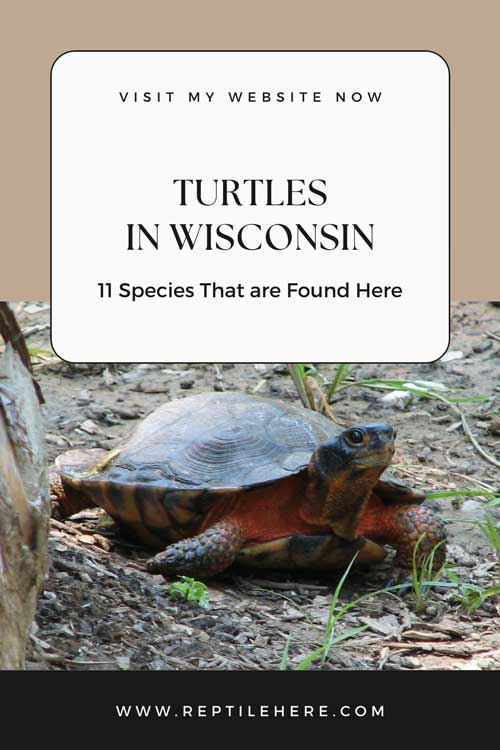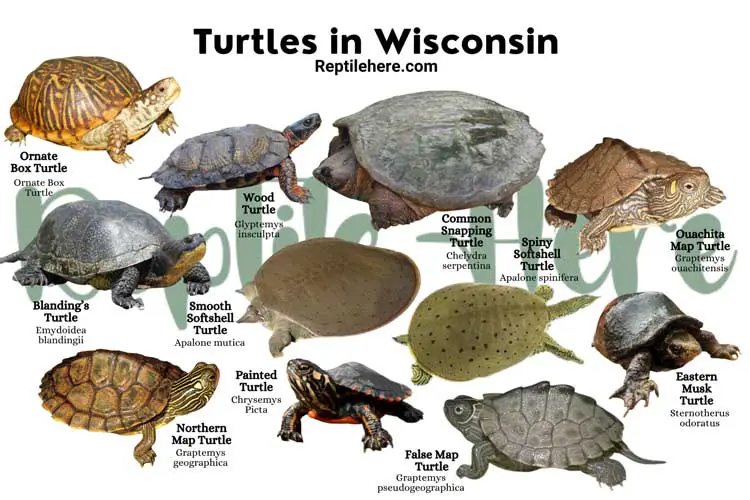Turtles in Wisconsin – 11 Species That are Found Here
Wisconsin is home to 11 turtle species. 10 of them are freshwater species and range from the common snapping turtles to painted turtles, and eastern musk turtles.
They also have one terrestrial species—the ornate box turtle—which roams the state’s woodlands, prairies, and grasslands regions
While most of the turtles found in this state are fairly common, some of them are considered threatened or endangered. They include the ornate box turtle (the only terrestrial turtle in the state), Blanding’s turtles, and wood turtle.
Luckily, Wisconsin has rules in place that make it illegal to capture these state or federally-protected species to ensure they’re not taken from the wild.
Listed below are all the turtles of Wisconsin and the basic info you need to know about each of them including habitat, diet, size, lifespan, and more.
11 Types Of Turtles in Wisconsin
Contents
1. Common Snapping Turtle
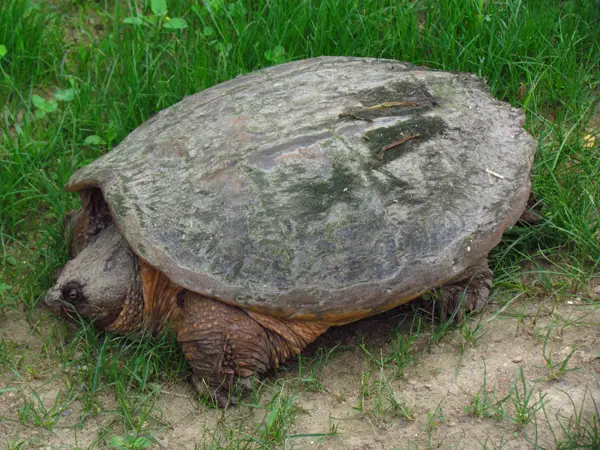
- Scientific name: Chelydra serpentina
- Common name: Snapping Turtle
- Family: Chelydridae
- Size: 8 to 18 1/2 inches
- Lifespan: 30 to 50 years or more
- Conservation status: Least Concern
Common snapping turtles are widespread throughout Wisconsin. An average adult is pretty large and has a shell length of 18½ inches long.
This species has a chunky head, a long tail, and large webbed feet. The shell color is black or olive and has no distinct pattern. These Wisconsin snapping turtles are known for their powerful jaws—they’re so strong that these turtles eat other turtles!
You’ll find them in waterbodies with muddy bottoms. Examples include marshes, ponds, lakes, rivers, and even shallow streams. They generally prefer waters with aquatic vegetation in plenty and foods such as fish, frogs, birds, etc.
These Wisconsin turtles generally show docile behavior but can get quite aggressive if taken out of water. The best way to calm it is to take it back to the waters, where it feels safe.
2. Smooth Softshell Turtle
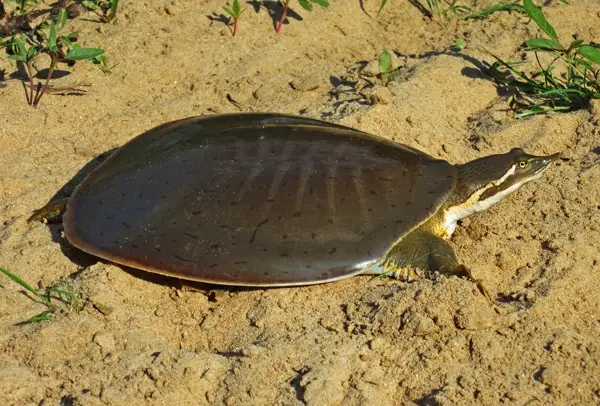
- Scientific name: Apalone mutica
- Common name: Midland Smooth Shell
- Family: Trionychidae
- Size: 6 to 13 inches
- Lifespan: 40 to 60 years
- Conservation status: Least Concern
The smooth softshell turtle boasts its position as the fastest turtle on land in Wisconsin! Though most people believe these turtles are slow-moving, they must be quick to enable them to outrun their predators given that their soft shells don’t offer much protection.
The Shell color of this turtle species ranges from olive to dark brown. The upper part of its shell features dark markings (with female markings appearing in a blotchier pattern than the males’)
The shell of these turtles also appears rounder and flatter, just like other softshell species.
Note that Gulf Coast smooth turtle (Apalone calvata) is the closes relative of this Midland smooth softshell turtle. The main difference existing between these two species is size, with the Gulf coast turtle reaching a maximum of 12 inches long.
Also, the Gulf coast species has no lines on its face while the midland smooth softshell turtle does.
These turtles like inhabiting waterbodies like rivers and streams in Wisconsin that provide an abundance of mud or sand at the bottom. They can also be found in stagnant waterbodies.
Smooth softshell turtles of Wisconsin are omnivorous and their diet revolves around aquatic vegetation and insects. However, they have been observed to like meat more than plant matter and will mainly eat snails, insects, and fish.
3. Spiny Softshell Turtle
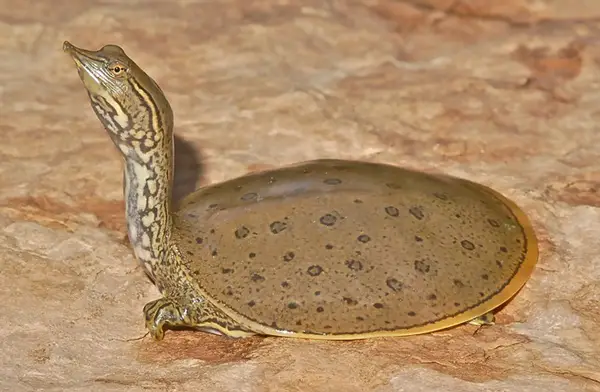
- Scientific name: Apalone spinifera
- Common name: Spiny Softshell Turtle
- Family: Trionychidae
- Size: 5 to 9 inches (males), 12 to 20 inches (females)
- Lifespan: 30 to 70 years
- Conservation status: Least Concern
The Spiny softshell turtle is a medium-to-large freshwater species that live in Wisconsin’s lakes, streams, and rivers with muddy or sandy bottoms and little or no vegetation.
Female spiny softshell turtles are usually larger than males. And unlike other turtles, this species has a flexible, leather-like carapace that’s extremely rounded and flattened. The shell color can be olive grey or yellow-brown. Just like other softshell turtles, this species also has a snorkel-like snout.
The young ones feature well-defined round spots that are easily visible on the shell (though these spots become invisible as they transition to adulthood).
Spiny softshell turtles in Wisconsin tend to eat anything they find in the waters including crayfish, insects, small fish, and so on. They hunt by burying themselves in the mud or sand while keeping their head uncovered to grab food as it swims by.
These turtles are also able to breathe underwater by taking in oxygen through their throat skin. This is a useful adaptation given that they don’t spend a lot of time out of water.
Other adaptations of these turtles include webbed feed, long claws, and extremely flat shells that enable them to quickly swim away from predators and burry in the muddy bottom of the waters they reside in.
4. Painted Turtle
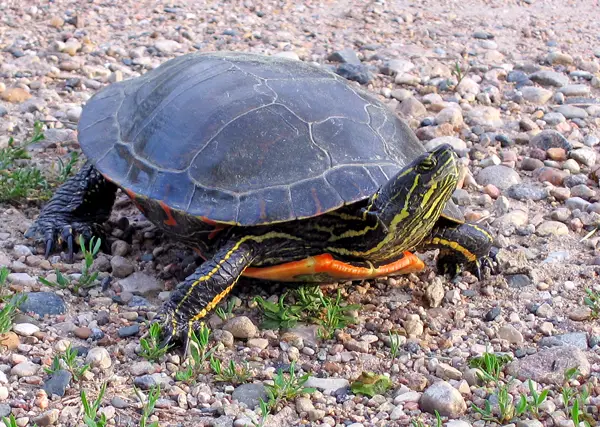
- Scientific name: Chrysemys Picta
- Common name: Painted Turtle
- Family: Emydidae
- Size: 4 to 10 inches
- Lifespan: 30 to 50 years
- Conservation status: Least Concern
Wisconsin is home to two subspecies of painted turtles namely the western painted turtle (Chrysemys Picta Belli) and the midland painted turtle (Chrysemys picta marginata).
Midland painted turtles are usually found around Caddo Lake near the border with the state of Louisiana while the western painted turtles are confined in several western counties.
Painted are generally identified by dark shells with yellow to red coloring at the edges. They have yellow stripes on their faces.
Midland painted turtles stand out from the other painted turtles due to dark, shadow-like patches at the center of their plastrons.
These turtles are mainly aquatic and can be spotted near the waters. They also like basking.
Being omnivorous, painted turtles in Wisconsin will feed on frogs, mollusks, and aquatic invertebrates. Note that they must swallow their food in water, meaning they must feed inside the water.
5. False Map Turtle
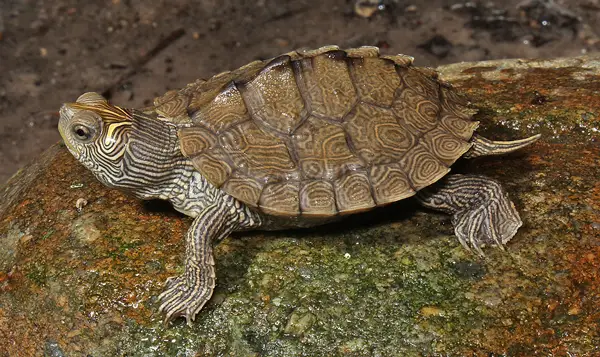
- Scientific name: Graptemys pseudogeographica
- Common name: False Map Turtle, Sawback Turtle
- Family: Emydidae
- Size: 6 to 10 inches (females), 3.5 to 6 inches (males)
- Lifespan: 30 to 50 years
- Conservation status: Least Concern
The False map turtle is another turtle species found in Wisconsin. This turtle’s preferred habitat in Wisconsin includes rivers, streams, and oxbow lakes of the Missouri and Mississippi river systems.
It is an excellent swimmer and prefers moderate currents and deep waters.
Its upper shell coloring ranges from olive to dark brown, with light-colored lines on its limbs. It also features a line behind its eye that forms a backward “L” shape. The map pattern on its carapace tends to fade as the turtle ages.
Since this map turtle of Wisconsin is omnivorous, it feeds on aquatic insects and animals as well as vegetation. It is fond of river snails and crustaceans. Don’t forget it has strong jaws and can give a nasty bite!
Like most of the other aquatic turtles of Wisconsin, this map turtle spends most of its waking hours sunning.
The false map turtle is quite shy and quietly and swiftly slides into the water at the slightest signs of disturbance. It likes spending most of its time in water and is most active in climate conditions of over 85 degrees Fahrenheit.
Also read: Turtles in North Dakota
6. Northern Map Turtle
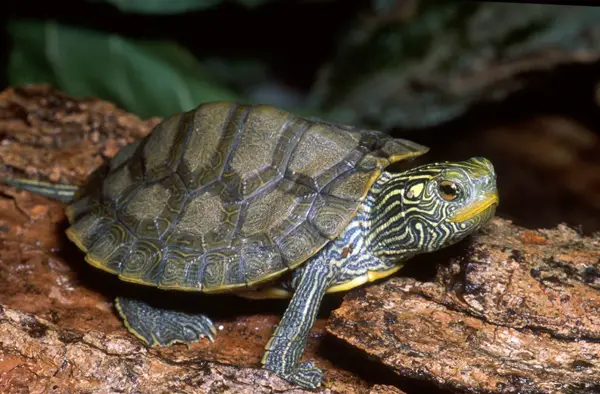
- Scientific name: Graptemys geographica
- Common name: Northern Map Turtle, Common Map Turtle
- Family: Emydidae
- Size: 3 to 10 inches
- Lifespan: 30 to 50 years
- Conservation status: Least Concern
The common map turtle has also been observed in Wisconsin. To be more specie, this freshwater turtle resides in the rivers and lakes of Wisconsin.
They prefer living in large waterbodies with debris. These offer the perfect spots for basking while the water bodies enable them to spend their hibernation periods in winter completely submerged.
Like other map turtles, this common map turtle gets its name from the map-like pattern on its shell. Its shell is typically darker and ranges from brown to black. The map pattern has a lighter coloration.
The common map turtle of Wisconsin is mainly carnivorous and feeds on mollusks such as clams and snails. It will also eat crayfish and insects. And when animal matter gets scarce, it will feed on plant matter.
Note that it may be difficult to spot a common map turtle in the wild in Wisconsin. Although active during the day, these turtles are quite timid and will quickly retreat to the waters at the slightest disturbance.
7. Ouachita Map Turtle
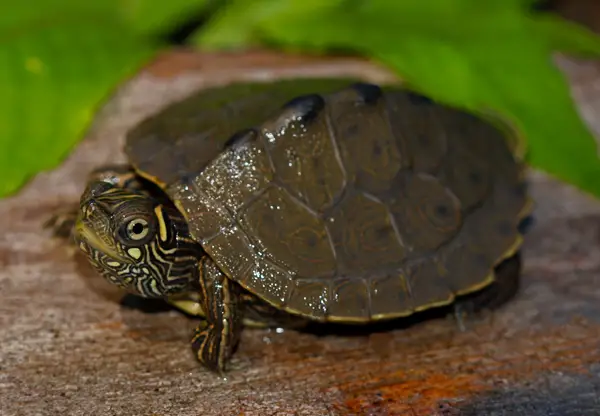
- Scientific name: Graptemys ouachitensis
- Common name: Ouachita Map Turtle, Map Turtle
- Family: Emydidae
- Size: 3 to 5 inches (males), 8 to 10 inches (females)
- Lifespan: 30 to 50 years
- Conservation status: Least Concern
The Ouachita map turtle lives in the northern part of Wisconsin and is regarded as one of the less popular map turtle species. The turtle makes an excellent choice of pet for many people since it’s easy to care for.
As for its name, this species is named after the river where it was discovered—Ouachita!
Ouachita turtle is medium to large in terms of size. The average adult female is 3-5 inches long while the male is 8 to 10 inches long. It features thin, yellowing lines that form a web on the turtle’s shell (similar to a contour elevation map).
Moreover, the turtle has brown to olive coloring, with a light spot under both eyes.
The easiest way to identify this Wisconsin turtle from other map turtle subspecies is by checking the dots on its face. They usually have 3 prominent spots—under the jawline, under the eye, and behind the eye.
Note that this turtle prefers living in stagnant or slow-moving waters, including ponds, lakes, and streams. of Wisconsin It also prefers waters with plenty of vegetation. This species is omnivorous and eats meat, insects, vegetables, fruits, and aquatic vegetation, to name but a few.
8. Eastern Musk Turtle
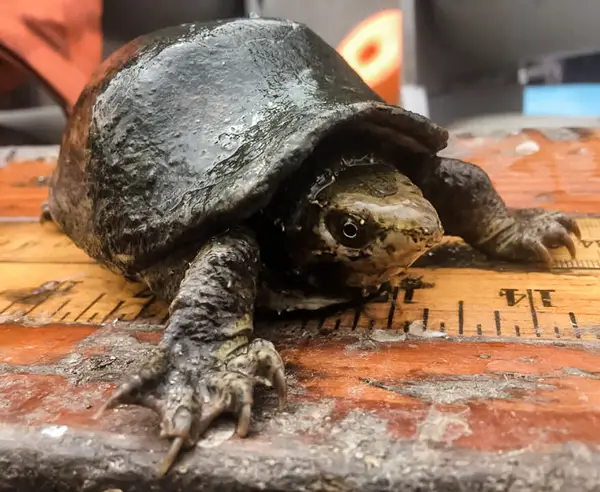
- Scientific name: Sternotherus odoratus
- Common name: Common Musk Turtle, Eastern Musk Turtle, Musk Turtle, Stinkpot
- Family: Kinosternidae
- Size: 2 to 4.5 inches
- Lifespan: 30 to 50 years
- Conservation status: Least Concern
The Eastern Musk Turtle is another aquatic turtle found in Wisconsin’s slow-moving and sluggish streams as well as still water bodies.
The turtle usually prefers areas with dark crevices, where it can easily hide. It also prefers lots of plant matter to burrow in and hide.
An average adult eastern musk turtle is quite small (2 to 4.5 inches long). It has a pretty plain appearance with highly consistent colors. Both the shell and skin usually share the same color and can range from dark brown to black.
The turtle shell has one unique feature—a ridge traversing its entire shell length. Besides, it has another distinctive feature: two light-colored stripes on its head.
Eastern musk turtles of Wisconsin are herbivorous and will eat small aquatic or semi-aquatic animals, carrion, and aquatic vegetation. They will also feed on any other vegetation on land.
When it feels threatened, this musk turtle species emits a foul odor (a musky odor, hence its name). This scent can be detected in water or on land. It can also easily waft through the air to its predators.
Also, these Wisconsin turtles are good at climbing trees! This great capability enables them to go high up tree branches to find a safe resting place and avoid predators.
9. Wood Turtle
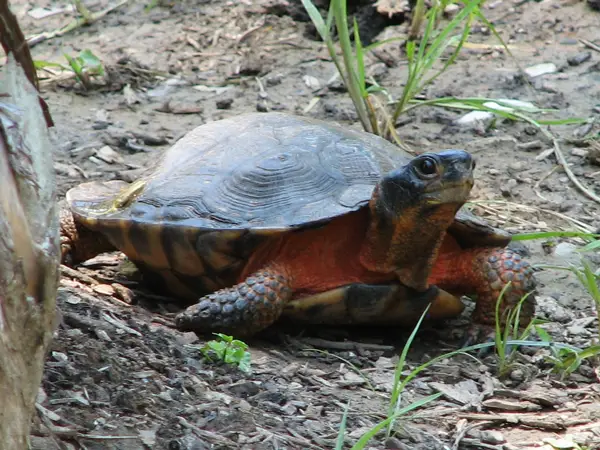
- Scientific name: Glyptemys insculpta
- Common name: Wood turtle, Sculptured Tortoise, Redleg, Red-legged Tortoise
- Family: Emydidae
- Size: 5.5 to 8 inches
- Lifespan: 40 to 60 years
- Conservation status: Endangered
Wood turtle species also inhabit the various woodland habitats across Wisconsin state. However, they also tend to stay near the water and will frequently venture into it.
During winter, they tend to hibernate at the bottom of deep rivers and pools.
The turtles get their name from their sculpted-like looks. Their upper shells are dark brown and have sport patterns resembling wood grain and growth rings.
Their scutes may sometimes appear like they’re pyramiding, further enhancing their sculpted shape.
Wood turtles of Wisconsin are diurnal omnivores and their diet mainly consists of berries, plants, insects, and mollusks.
They forage for their food widely and have even been observed stomping their feet on the ground as a way of tricking the earthworms into surfacing.
10. Blanding’s Turtle
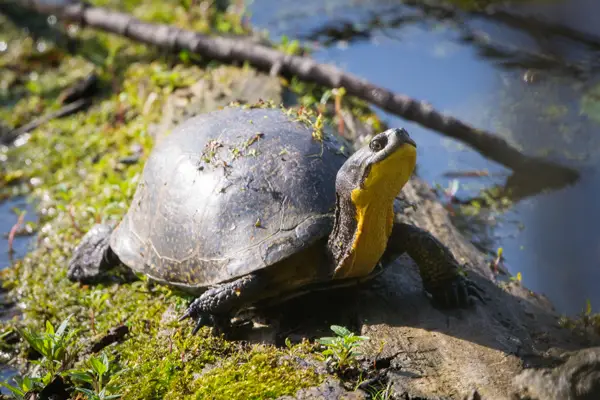
- Scientific name: Emydoidea blandingii
- Common name: Blanding’s Turtle
- Family: Emydidae
- Size: 5 to 8 inches
- Lifespan: up to 80 years (or more!)
- Conservation status: Endangered
Blanding’s Turtle is also known as the “turtle that smiles” and is named in honor of William Blanding, the American naturalist.
This turtle is semi-aquatic and is categorized under endured species in Wisconsin. It is mainly concentrated in the northern half of this state, but its population is quite scattered—making it hard to find.
The Blanding’s turtle has a dark oval shell covered with faint yellow speckles. The lower side of its shell is usually yellow with black patches.
Blanding’s turtle in Wisconsin prefers living in marshy habitats. And the fact that it’s losing these favorite habitats is one of the reasons causing its population to decline fast.
Because this turtle species in Wisconsin is omnivorous, it feeds on leatherworks, crayfish, and aquatic invertebrates.
It also occasionally feeds on plants and doesn’t rely on water to help it sallow its food as it’s the case with most turtle species.
11. Ornate Box Turtle
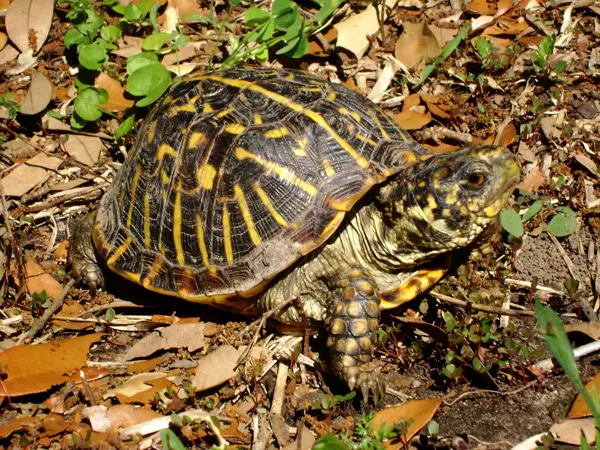
- Common name: Ornate Box Turtle
- Family: Emydidae
- Size: 5 to 7 inches
- Lifespan: 40 to 60 years
- Conservation status: Near Threatened
Ornate box turtles are present in Wisconsin and are recognized by the beautiful pattern on their carapace. This eye-pleasing pattern is sometimes referred to as a starburst pattern.
Their skin is grey and may feature yellow or white spots. Male heads occasionally feature a green color.
Though there exists little distinction between the males and females of these Wisconsin box turtles, the males are generally smaller than the females.
During hot weather, this turtle requires water to help regulate its body temperature.
The Wisconsin species of turtle are known to hibernate in burrows during cold weather. They’re also capable of surviving in frozen soils for several days.
Being omnivorous in nature, and opportunistic feeders, these turtles will gladly eat anything available to them in their habitat or what’s abundant in a given season.
They have been observed eating fruits, vegetables, grasshoppers, and various other insects.
Related: Turtles of Alabama
Conclusion
That’s it for our list of the 11 native turtles of Wisconsin. Nearly all the turtles in Wisconsin are freshwater species. Only one terrestrial species, the ornate box turtle, is found in the state.
The aquatic turtles of Wisconsin include common snapping turtles, painted turtles, false map turtles, northern map turtles, softshell turtles, Blanding’s turtles, wood turtles, eastern musk turtles, and others.
Remember, some of the turtles are classified as threatened or endangered and it’s illegal to capture them in the Wisconsin wild. Any federally protected turtle species on this list is also illegal to capture.
